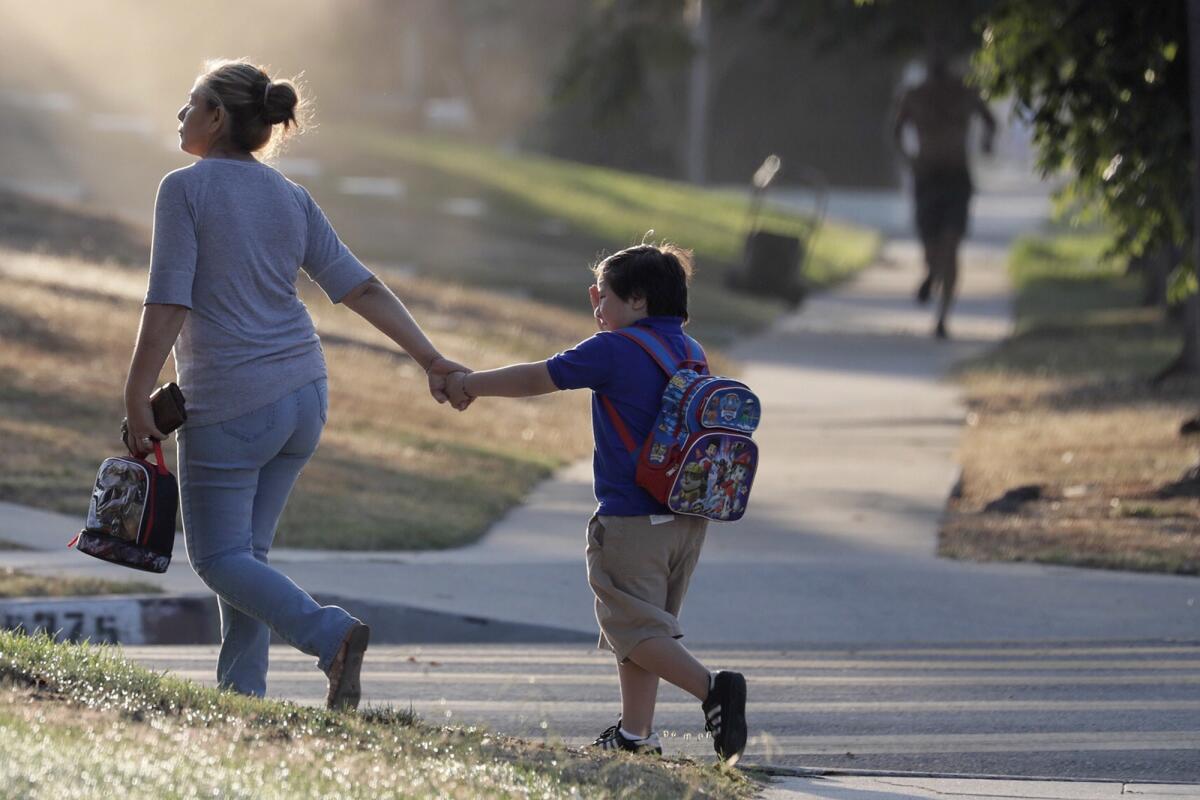California’s children fall behind before they start school, and some never catch up, study finds

- Share via
When students enter school in California, they learn at a pace on par with — if not better than — those in other states.
The problem is that they arrive far behind their national peers, and they never catch up.
This conclusion, from a sweeping research project aimed at charting future education policy, focuses new attention on what is often overlooked: infant and toddler care, parenting skills, preschool and early childhood education.
The researchers argue that if California wants to improve student achievement in schools, it has to start much earlier so that children are prepared when they show up for kindergarten.
Many “don’t have access to any care, let alone quality care,” said Stanford University education professor Deborah Stipek, one of the lead researchers. “It’s not just a problem for low-income families, although affordability is a serious issue. It’s a problem for many, many families because fewer people are going into being providers for child care.”
Those who tend to be least prepared for school are low-income Latino and black students, including recent immigrants and those in foster care, the experts said.
And this is connected to another challenge facing educators in California: The achievement gap between Asian and white students and their black and Latino peers. Data shows all students are doing better but that the gap is not closing.
Other states have made more progress. Ten years ago, eight states had a larger achievement gap than California when comparing white and Latino students in eighth-grade reading. Now, only four have larger gaps.
“We’re moving backward in that respect,” said Christopher Edley Jr., president of the Opportunity Institute, a nonprofit organization that took part in the research.
A key component of the remedy is more money, the researchers said. The knotty question: where dollars should be invested. Some advocates favor higher teacher salaries to attract and retain the best talent. Others focus on providing more counseling and health support to older students. There are needs in these areas and others.
The idea of providing needed support from birth onward — as part of an education plan — is not new. It’s embodied in such smaller-scale projects as the Harlem Children’s Zone, where generous private funding helps children from birth to college. Many see the Harlem project as a model, but an expensive one and therefore hard to replicate.
Stipek said one reason California children are unprepared for school is a lack of quality child care and preschool.
More than half of the people who provide child care qualify for federal or state welfare or other forms of public assistance, Stipek said.
“That tells you something about the salaries that are paid,” she said.
Compared with other states, California also has lower standards for child-care providers and preschool teachers. But tightening standards alone would only exacerbate the shortage of workers, Stipek said.
The research released Monday comprises 36 studies and involved more than 100 experts who examined a broad range of topics. They looked at new and recent data and did some of their own number-crunching. A similar effort 10 years ago became the launching pad for the education reforms of Gov. Jerry Brown.
One goal was to evaluate the Brown-era measures, which directed a substantial infusion of new money to help the neediest students — English learners, students in foster care and those from low-income families — as they moved through grade school. But the new research suggests this extra help needs to start sooner.
The extra money provided through Brown’s reforms did have an impact. The researchers found a correlation between increased money and higher graduation rates. Efforts by Brown and the Legislature also have included a new testing and accountability system as well as an attempt to move control over schools closer to the local level.
In all, the researchers were not prepared to judge whether these measures worked as intended, because the new data — which suggested California’s student achievement improved at a faster rate than the nation at large — yielded both encouraging and disappointing findings.
The state-by-state comparison is based on the National Assessment of Educational Progress. NAEP compiles results from a sampling of fourth- and eighth-grade students, who are tested in math and reading. While the NAEP results are not new, this latest research effort analyzed these scores within the broader context of state policies.
By important measures, California has made progress.
For example, in 2007, only three states trailed California in scores for eighth-grade reading. This latest review shows that California has landed ahead of 14 other states. But California students still were scoring well below the national average in math and reading.
The researchers also looked at the state of school finances and found reason for alarm because of problems with state pension funds and other issues. These concerns are not new.
But one newer wrinkle was an analysis comparing California teacher salaries to the state’s overall level of education funding. It turns out, according to the research, that comparatively high teacher salaries take up more funding than in other states, with the result that fewer employees can be hired to work in schools.
Twitter: @howardblume
More to Read
Sign up for Essential California
The most important California stories and recommendations in your inbox every morning.
You may occasionally receive promotional content from the Los Angeles Times.











